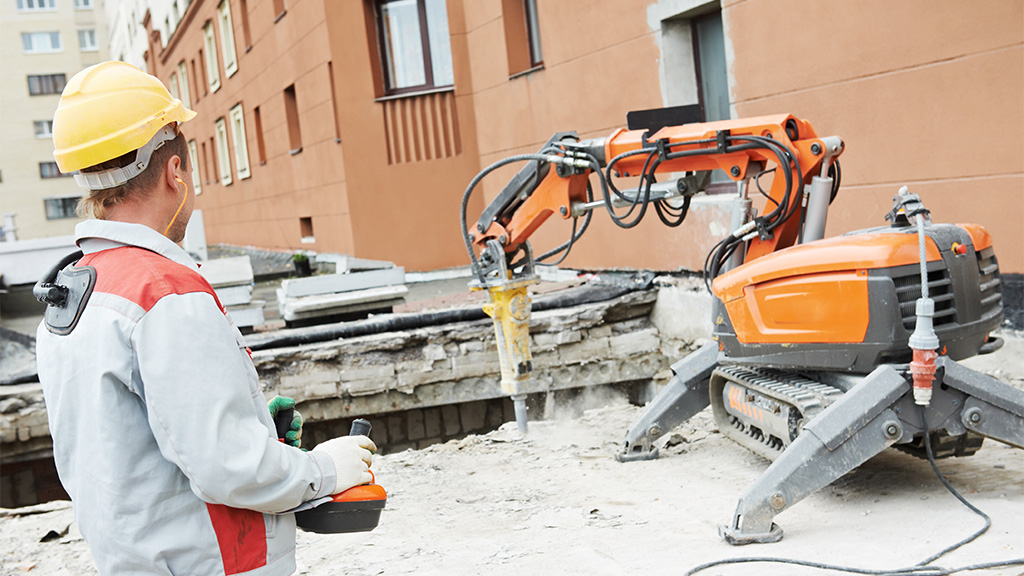The thing about change is sometimes it creeps up on us.
Take robotics in construction. They’re already deployed and working.
Did we notice?
Sure, these are early designs and entry level for the most part, but they are here and growing in both capability and application, much like the personal computer or mobile phone when it first arrived. At first, an expensive novelty. Now an indispensable tool for both business and recreation that fits in our pockets.
While things are picking up in Canada, we’re far behind the rest of the world.
Certainly, drones, robotic dogs, bricklaying machines, paving stone machines have already been built and deployed.
Bulldozers can level a site guided by their software perimeter guidelines. Small robotic devices are chipping away at concrete on demolition jobs. And there’s usually a human role in there somewhere.
沃尔沃的重型设备可能来自许多操作miles away, but there’s a human in the chair toggling the controls. It’s the same with mine face robots.
In Europe, modular factories are commonplace but perhaps no one is as advanced as the Chinese where the fast growing nation is banking heavily on more factories staffed by robots as it ramps up production of just about everything, including construction.
Bright Dream has built 18 construction robots that have been used in 120 projects around the world carrying out painting, sanding concrete pours, pouring concrete, floating concrete and more. Meanwhile, satellite-guided robots are building roads, right down to the final finish.
The most ambitious Chinese robot project is also set to launch, building a massive hydro dam in Tibet by 2024.
The South China Morning Post reports the 180-metre-high, Yangqu dam will control the robots through AI, printing the structure layer by layer, supply materials through driverless transport trucks, bulldozers, pavers and rollers.
In Canada, we’re on the road. Robotics are also on deck at the Bruce Power nuclear reactor refurbishments where a $25 billion series of upgrades are slated through mid-2060 on the eight units there.
Byron House, senior director of tooling and innovation for major projects at Bruce Power, says two robots from ATS Automated Tooling Systems in Cambridge, Ont. are set to report for work in spring 2023. It’s part of a $40 million contract first signed in 2016 which was expanded to $60 million in 2018.
“Putting in the fuel channels involves 26 steps and it’s highly repetitious,” he says, noting each unit has 480 channels with 960 smaller tubes. “The contract with the province requires we find savings by innovation over time and become more efficient, so we started to look at automation. Protecting workers and minimizing their exposure to any radiation is also a considerable factor.”
Human tradespeople will still be required to assemble material and prepare it for the machines, but the overall impact, it is hoped, will be to increase the production rate.
“There won’t be a workforce reduction,” he says.
两个机器人——或者他们称为自动化工具— will be working on Unit 3 in Q1 2023, first in removing the inner pressure tube and the larger calandria tubes, then to inspect and prepare components for insertion.
Those Chinese robots are producing highrise structures in a matter of months, says Chris Rausch who works with Carl Haas at the University of Waterloo and has worked automating workflows in construction.
More recently he has been developing algorithms and automated solutions for adaptive building reuse, prefabrication and offsite construction.
He sees an “increasing appetite for automation and robotics in construction.”
Canada is also advanced in developing factory built prefabricated panels for home construction but there are hurdles.
Mass production techniques and technologies don’t always transfer well into the construction sector because there’s little room for customization.
“If you’re building a Ford F-150 chassis you optimize the design for mass production,” he says. “It doesn’t really work that way in construction, though there has to be some standardization.”
The economies of scale in producing 50,000 F-150 bodies with robots brings efficiencies but construction projects have much lower production numbers and don’t reach that level of efficiency.
For robotic prefabricated modules to take off there’s going to be a learning curve where the focus should be on quality over quantity of production and that could apply to any area of automation in construction.
“First, gain a level of competence, then add complexity to get to the goal in a realistic manner, not biting off more that you can chew.”









Recent Comments
comments for this post are closed